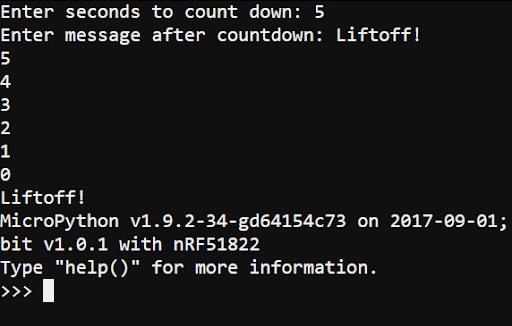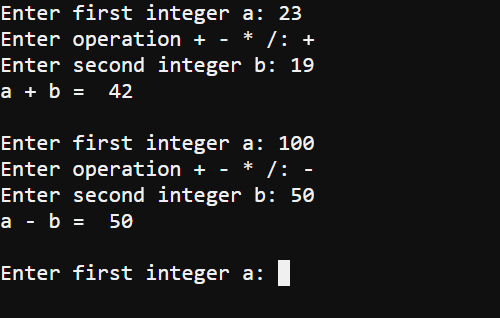Now that your micro:bit scripts can receive values from the terminal, let’s put those values to work in an app. This first example is a countdown timer that allows you to set the number of seconds in the countdown.

- Enter, name, and save countdown_timer.
- Click the Send to micro:bit button.
# countdown_timer.py
from microbit import *
sleep(1000)
text = input("Enter seconds to count down: ")
value = int(text)
message = input("Enter message after countdown: ")
while value >= 0:
print(value)
sleep(1000)
value = value - 1
print(message)
- Click Show serial.
- Click to the right of the "Enter seconds to count down: " prompt.
- Type a number and press Enter.
- The program will then prompt you with Enter message after countdown:. Type the message you want it to display, then press Enter..
- Verify that the terminal counts down to zero from the starting value you gave it, and then displays your custom message.
- Click Hide serial.
How it Works
First, the script captures the text representation of a number you type into the terminal. This gets converted into an int value that the script can store and use for counting repetitions. This int value gets stored in the value variable.
text = input("Enter seconds to count down: ")
value = int(text)
The text you type in response to the message prompt gets stored as a string of characters in the message variable, which is a string.
message = input("Enter message after countdown: ")
Since the value variable now stores an int variable, it can use it to control how many times this while loop repeats:
while value >= 0:
print(value)
sleep(1000)
value = value - 1
After the while loop is done, your custom message gets displayed.
print(message)
Try This: Calculator App
This is another way of using text and values from the terminal — a calculator app.

- Enter, name, and save the calculator script.
- Click the Send to micro:bit button.
# calculator.py
from microbit import *
sleep(1000)
while True:
text = input("Enter first integer a: ")
a = int(text)
op = input("Enter operation + - * /: ")
text = input("Enter second integer b: ")
b = int(text)
if op == "+":
c = a + b
elif op == "-":
c = a - b
elif op == "*":
c = a * b
elif op == "/":
c = a / b
print("a", op, "b = ", c)
print(" ")
- Click the Show serial button.
- Test the calculator app, and verify that it works. Make sure to press Enter after each value and operator you type.
- When you are done, click Hide serial.
Your Turn: An Interval Timer
Interval timers repeatedly count down the same amount of time, and are used to control the amount of time one has to repeatedly run a sprint or swim a lap, including rest. They are also used in stretching after a workout so that each stretch is only done for a fixed amount of time.
- Make the app ask for the seconds countdown, and the number of reps.
- Then, the interval timer will countdown the number of seconds you entered, and it will repeat that countdown the number of times you typed for reps.
- After you get it working, put the routine in a while True loop so that it it starts over again, asking you for seconds and reps after the first set of intervals.
It helps to break this program into steps. Here is some pseudo-code that you can work from to build the program:
Outer loop always repeats
Get the countdown seconds and store in an int variable.
Get the reps and store in an int variable.
while reps > 0
copy countdown seconds to a temporary variable.
Print start interval message
while temporary variable > 0
Print temporary variable
Wait a second
Subtract 1 from temporary variable.
Subtract 1 from reps
Print done with set
Hint: Make the indentation levels in the pseudo code match the indentation levels in your code.
